Immunomodulation in the canine endometrium by uteropathogenic Escherichia coli
- PMID: 27829462
- PMCID: PMC5103487
- DOI: 10.1186/s13567-016-0396-z
Immunomodulation in the canine endometrium by uteropathogenic Escherichia coli
Abstract
This study was designed to evaluate the role of E. coli α-hemolysin (HlyA) in the pathogenesis of canine pyometra, and on the immune response of canine endometrial epithelial and stromal cells. In Experiment 1, the clinical, hematological, biochemical and uterine histological characteristics of β-hemolytic and non-hemolytic E. coli pyometra bitches were compared. More (p < 0.05) metritis cases were observed in β-hemolytic E. coli pyometra uteri than in non-hemolytic E. coli pyometra uteri. β-hemolytic E. coli pyometra endometria had higher gene transcription of IL-1β and IL-8 and lower gene transcription of IL-6 than non-hemolytic E. coli pyometra endometria (p < 0.01). In Experiment 2, the immune response of endometrial epithelial and stromal cells, to hemolytic (Pyo18) and non-hemolytic E. coli strains (Pyo18 with deleted hlya-Pyo18ΔhlyA- and Pyo14) were compared. Following 4 h of incubation, Pyo18 decreased epithelial cell numbers to 54% (p < 0.001), and induced death of all stromal cells (p < 0.0001), whereas Pyo18ΔhlyA and Pyo14 had no effect on cell numbers. Compared to Pyo18ΔhlyA and Pyo14, respectively, Pyo18 induced a lower transcription level of IL-1β (0.99 vs 152.0 vs 50.9 fold increase, p < 0.001), TNFα (3.2 vs 49.9 vs 12.9 fold increase, p < 0.05) and IL-10 (0.4 vs 3.6 vs 2.6 fold increase, p < 0.001) in stromal cells, after 1 h of incubation. This may be seen as an attempt of hemolytic E. coli to delay the activation of the immune response. In conclusion, endometrial epithelial and stromal cell damage induced by HlyA is a potential relevant step of E. coli virulence in the pathogenesis of pyometra.
Figures
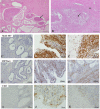
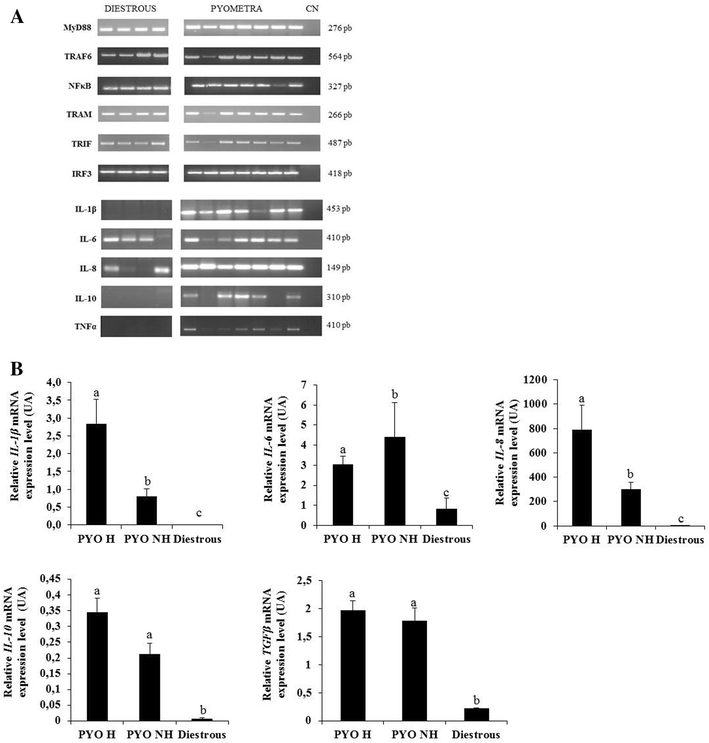

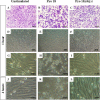

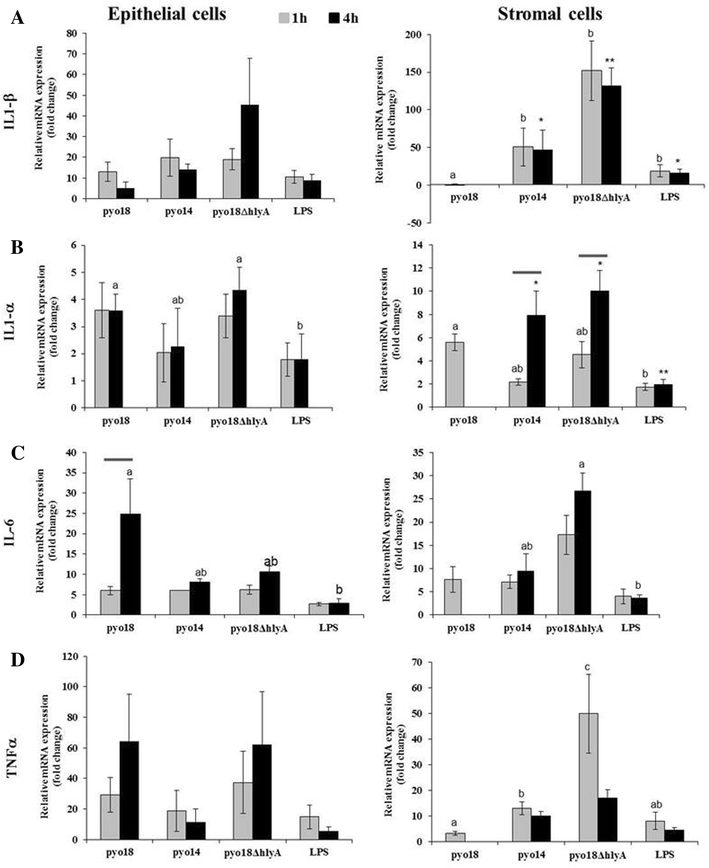
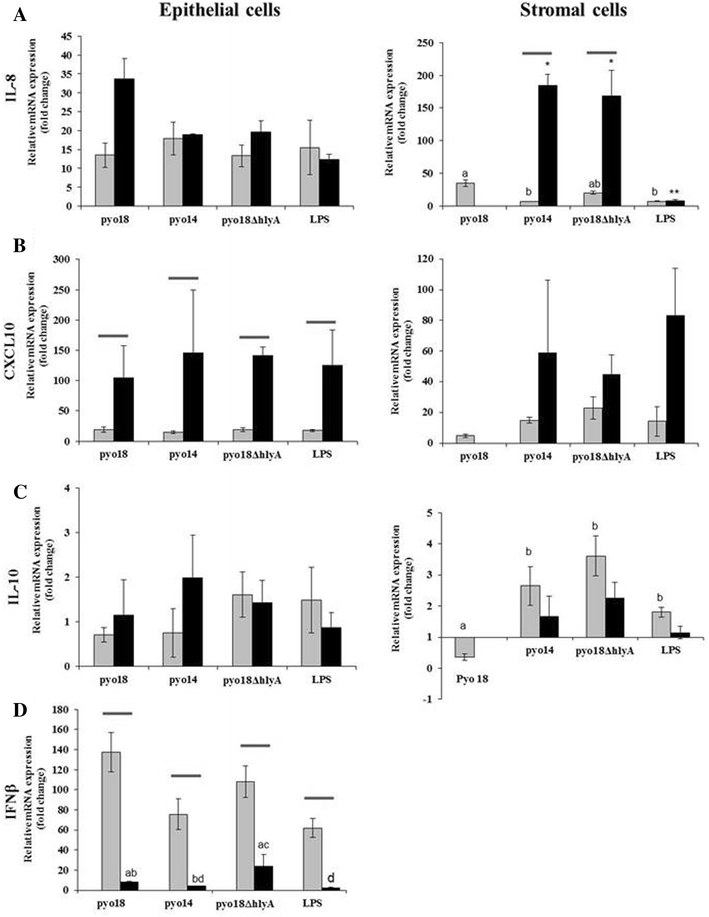
Similar articles
-
Uropathogenic virulence factor FimH facilitates binding of uteropathogenic Escherichia coli to canine endometrium.Comp Immunol Microbiol Infect Dis. 2012 Sep;35(5):461-7. doi: 10.1016/j.cimid.2012.04.001. Epub 2012 May 2. Comp Immunol Microbiol Infect Dis. 2012. PMID: 22554919
-
Pathogenic Escherichia coli and lipopolysaccharide enhance the expression of IL-8, CXCL5, and CXCL10 in canine endometrial stromal cells.Theriogenology. 2015 Jul 1;84(1):34-42. doi: 10.1016/j.theriogenology.2015.02.008. Epub 2015 Feb 13. Theriogenology. 2015. PMID: 25765298
-
Gene transcription of TLR2, TLR4, LPS ligands and prostaglandin synthesis enzymes are up-regulated in canine uteri with cystic endometrial hyperplasia-pyometra complex.J Reprod Immunol. 2010 Jan;84(1):66-74. doi: 10.1016/j.jri.2009.10.004. Epub 2009 Nov 28. J Reprod Immunol. 2010. PMID: 19945173
-
Pyometra in Small Animals.Vet Clin North Am Small Anim Pract. 2018 Jul;48(4):639-661. doi: 10.1016/j.cvsm.2018.03.001. Vet Clin North Am Small Anim Pract. 2018. PMID: 29933767 Review.
-
Canine Pyometra: A Short Review of Current Advances.Animals (Basel). 2023 Oct 25;13(21):3310. doi: 10.3390/ani13213310. Animals (Basel). 2023. PMID: 37958065 Free PMC article. Review.
Cited by
-
Characterization of Escherichia coli in Dogs with Pyometra and the Influence of Diet on the Intestinal Colonization of Extraintestinal Pathogenic E. coli (ExPEC).Vet Sci. 2022 May 22;9(5):245. doi: 10.3390/vetsci9050245. Vet Sci. 2022. PMID: 35622773 Free PMC article.
-
Biofilm forming potentiality of Escherichia coli isolated from bovine endometritis and their antibiotic resistance profiles.J Adv Vet Anim Res. 2020 Aug 5;7(3):442-451. doi: 10.5455/javar.2020.g440. eCollection 2020 Sep. J Adv Vet Anim Res. 2020. PMID: 33005670 Free PMC article.
References
-
- Dhaliwal GK, Wray C, Noakes DE. Uterine bacterial flora and uterine lesions in bitches with cystic endometrial hyperplasia (pyometra) Vet Rec. 1998;143:659–661. - PubMed
Publication types
MeSH terms
Substances
LinkOut - more resources
Full Text Sources
Other Literature Sources
Medical

